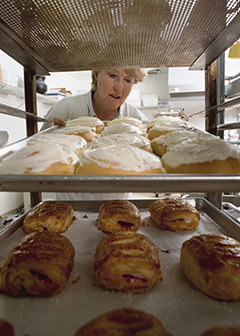Summary

| Quick Facts: Bakers | |
|---|---|
|
$23,450 per year
$11.27 per hour |
|
| Less than high school | |
| None | |
| Long-term on-the-job training | |
| 149,800 | |
| 2% (Little or no change) | |
| 3,500 | |
What Bakers Do
Bakers mix and bake ingredients according to recipes to make a variety of breads, pastries, and other baked goods.
Work Environment
Most bakers work in bakeries, grocery stores, and restaurants. Some, however, work in manufacturing facilities that produce breads and pastries in large quantities. The majority of bakers work full time, and their shifts often include early mornings, late evenings, weekends, and holidays.
How to Become a Baker
Although long-term on-the-job training is the most common path to becoming a baker, some start their careers through an apprenticeship program or by attending a technical or culinary school. No formal education is required.
Pay
The median annual wage of bakers was $23,450 in May 2010.
Job Outlook
Employment of bakers is expected to experience little or no change from 2010 to 2020. Highly skilled bakers with years of experience should have the best job opportunities because of the time it takes to learn to make these products and the growing demand for specialty baked products.
Similar Occupations
Compare the job duties, education, job growth, and pay of bakers with similar occupations.
O*NET
O*NET provides comprehensive information on key characteristics of workers and occupations.
Contacts for More Information
Learn more about bakers by contacting these additional resources.






